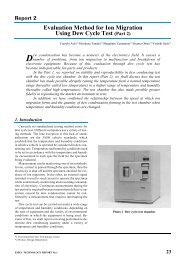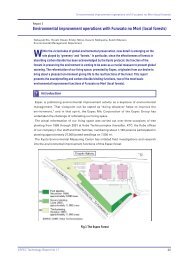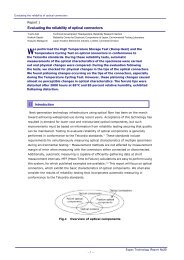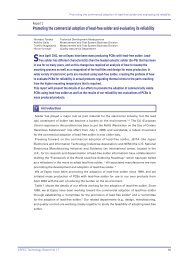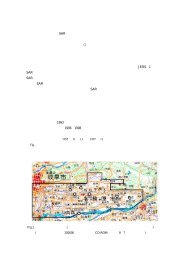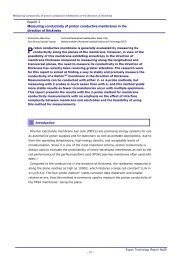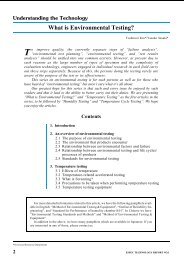Download
Download
Download
You also want an ePaper? Increase the reach of your titles
YUMPU automatically turns print PDFs into web optimized ePapers that Google loves.
3-3 Serving as a manual<br />
The standards do not merely determine test conditions<br />
and the method and sequence of the test. Standards also<br />
offer reference data, present techniques for running the<br />
test skillfully, and provide valuable information on<br />
organizing and judging test results.<br />
The atmospheric data recorded in the US military<br />
standard MIL-STD-810, for example, is generally very<br />
difficult to obtain. In such cases, standards can be used as<br />
manuals.<br />
3-4 Providing a source of information on test<br />
trends<br />
Given the dizzying pace of today’s technical progress,<br />
standards rarely endure over long periods of years, instead<br />
being frequently revised in accord with current<br />
conditions. As has been mentioned, information is<br />
relatively scarce in the arena of environmental testing,<br />
and investigating test trends in this secretive atmosphere<br />
can be very time-consuming. However, the effort to<br />
obtain information concerning transitions or revisions of<br />
standards is a means of obtaining valuable information on<br />
recent technological trends in testing, and should not be<br />
neglected.<br />
4. Classification of standards<br />
Various methods are used to classify standards.<br />
Classification can be made according to the organizations<br />
managing the standards, it can be made according to the<br />
items to which the standards are applied, or it can be<br />
made according to the purpose of the standards. More<br />
classification methods exist than can be enumerated. Let’s<br />
look at some examples of classification.<br />
2<br />
(a) Classification according to the organization managing<br />
the standard — Refer to Table 1.<br />
(b) Classification according to the items to which the<br />
standards are applied<br />
[Example of plastics]<br />
ISO 178 Plastics-Determination of flexural<br />
properties<br />
ISO 4892-1 Plastics-Methods of exposure to<br />
laboratory light sources-Part 1: General<br />
guidance<br />
JIS K 6900 Plastics-Vocabulary<br />
(c) Classification according to purpose<br />
[Example of temperature tests]<br />
IEC 60068-2-2 Environmental testing.<br />
Part 2: Tests. Test B: Dry heat<br />
MIL-STD-810 Method 501 High temperature<br />
Below are examples of classification based on the<br />
managing organizations (Table 1). These can be broadly<br />
divided into international standards, regional standards,<br />
national standards, and group standards.<br />
5. Overview of major environmental<br />
testing standards<br />
5-1 IEC (International Electrotechnical<br />
Commission)<br />
The IEC sets standards in the field of electricity and<br />
electronics, and is headquartered in Geneva, Switzerland.<br />
Currently, as of November 2000, the group counts 61<br />
member nations, including Japan. Since the IEC standards<br />
cannot issue standards without international agreement,<br />
the contents of the standards reflect concessions to the<br />
circumstances of various countries.<br />
Table 1 Classification of standards (Classification by managing organizations)<br />
Classification Major standards<br />
International standards<br />
Standards created through international<br />
cooperation for the mutual benefit of various<br />
countries and employed throughout the world.<br />
Regional Standards<br />
Standards established and applied within the<br />
limits of a specific region.<br />
National standards<br />
Domestic standards established by authorized<br />
agencies and created through mutual agreement<br />
of various interested parties of that country.<br />
Organizational Standards<br />
Institutes and industrial organizations handle<br />
standardization as one of their activities.<br />
Standards are created by agreement among the<br />
members, and so as a rule are used within the<br />
organization, or to facilitate their dealings and<br />
transactions.<br />
ISO (International Organization for Standardization)<br />
Responsible for standardization in fields other than electricity and electronics.<br />
Examples include the ISO 9000 Series (quality management systems) and the<br />
ISO 14000 Series (environmental management systems).<br />
IEC (International Electrotechnical Commission)<br />
Responsible for standardization in the fields of electricity and electronics.<br />
EN (European Unified Standards)<br />
Unified standards set by the CEN (The European Committee for<br />
Standardization) and CENELEC(European Committee For Electrotechnical<br />
Standardization)<br />
Japan<br />
USA<br />
Britain<br />
Germany<br />
China<br />
Japan<br />
USA<br />
JIS (Japan Industrial Standards)<br />
ANSI (American National Standards)<br />
BS (British Standard)<br />
DIN (Deutsche Institute für Normung)<br />
GB (Guojia Biaozhum)<br />
JASO (Japan Automobile Standards Organization)<br />
EIAJ (Japan Electronics and Information Technology Industries<br />
Association)<br />
JTM (Testing Machinery Association of Japan)<br />
MIL (US Military Standards) and so on<br />
ESPEC TECHNOLOGY REPORT No. 12



